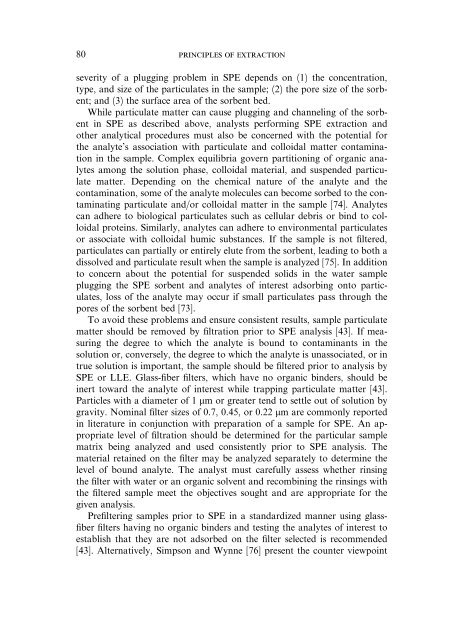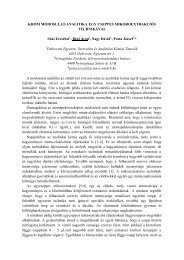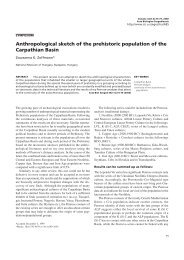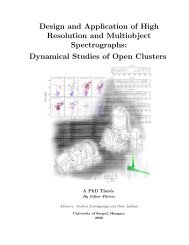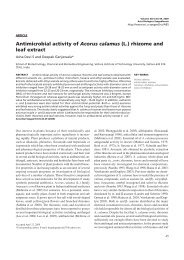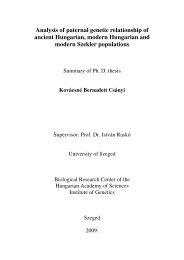principles of extraction and the extraction of semivolatile organics ...
principles of extraction and the extraction of semivolatile organics ...
principles of extraction and the extraction of semivolatile organics ...
Create successful ePaper yourself
Turn your PDF publications into a flip-book with our unique Google optimized e-Paper software.
80 <strong>principles</strong> <strong>of</strong> <strong>extraction</strong><br />
severity <strong>of</strong> a plugging problem in SPE depends on (1) <strong>the</strong> concentration,<br />
type, <strong>and</strong> size <strong>of</strong> <strong>the</strong> particulates in <strong>the</strong> sample; (2) <strong>the</strong> pore size <strong>of</strong> <strong>the</strong> sorbent;<br />
<strong>and</strong> (3) <strong>the</strong> surface area <strong>of</strong> <strong>the</strong> sorbent bed.<br />
While particulate matter can cause plugging <strong>and</strong> channeling <strong>of</strong> <strong>the</strong> sorbent<br />
in SPE as described above, analysts performing SPE <strong>extraction</strong> <strong>and</strong><br />
o<strong>the</strong>r analytical procedures must also be concerned with <strong>the</strong> potential for<br />
<strong>the</strong> analyte’s association with particulate <strong>and</strong> colloidal matter contamination<br />
in <strong>the</strong> sample. Complex equilibria govern partitioning <strong>of</strong> organic analytes<br />
among <strong>the</strong> solution phase, colloidal material, <strong>and</strong> suspended particulate<br />
matter. Depending on <strong>the</strong> chemical nature <strong>of</strong> <strong>the</strong> analyte <strong>and</strong> <strong>the</strong><br />
contamination, some <strong>of</strong> <strong>the</strong> analyte molecules can become sorbed to <strong>the</strong> contaminating<br />
particulate <strong>and</strong>/or colloidal matter in <strong>the</strong> sample [74]. Analytes<br />
can adhere to biological particulates such as cellular debris or bind to colloidal<br />
proteins. Similarly, analytes can adhere to environmental particulates<br />
or associate with colloidal humic substances. If <strong>the</strong> sample is not filtered,<br />
particulates can partially or entirely elute from <strong>the</strong> sorbent, leading to both a<br />
dissolved <strong>and</strong> particulate result when <strong>the</strong> sample is analyzed [75]. In addition<br />
to concern about <strong>the</strong> potential for suspended solids in <strong>the</strong> water sample<br />
plugging <strong>the</strong> SPE sorbent <strong>and</strong> analytes <strong>of</strong> interest adsorbing onto particulates,<br />
loss <strong>of</strong> <strong>the</strong> analyte may occur if small particulates pass through <strong>the</strong><br />
pores <strong>of</strong> <strong>the</strong> sorbent bed [73].<br />
To avoid <strong>the</strong>se problems <strong>and</strong> ensure consistent results, sample particulate<br />
matter should be removed by filtration prior to SPE analysis [43]. If measuring<br />
<strong>the</strong> degree to which <strong>the</strong> analyte is bound to contaminants in <strong>the</strong><br />
solution or, conversely, <strong>the</strong> degree to which <strong>the</strong> analyte is unassociated, or in<br />
true solution is important, <strong>the</strong> sample should be filtered prior to analysis by<br />
SPE or LLE. Glass-fiber filters, which have no organic binders, should be<br />
inert toward <strong>the</strong> analyte <strong>of</strong> interest while trapping particulate matter [43].<br />
Particles with a diameter <strong>of</strong> 1 mm or greater tend to settle out <strong>of</strong> solution by<br />
gravity. Nominal filter sizes <strong>of</strong> 0.7, 0.45, or 0.22 mm are commonly reported<br />
in literature in conjunction with preparation <strong>of</strong> a sample for SPE. An appropriate<br />
level <strong>of</strong> filtration should be determined for <strong>the</strong> particular sample<br />
matrix being analyzed <strong>and</strong> used consistently prior to SPE analysis. The<br />
material retained on <strong>the</strong> filter may be analyzed separately to determine <strong>the</strong><br />
level <strong>of</strong> bound analyte. The analyst must carefully assess whe<strong>the</strong>r rinsing<br />
<strong>the</strong> filter with water or an organic solvent <strong>and</strong> recombining <strong>the</strong> rinsings with<br />
<strong>the</strong> filtered sample meet <strong>the</strong> objectives sought <strong>and</strong> are appropriate for <strong>the</strong><br />
given analysis.<br />
Prefiltering samples prior to SPE in a st<strong>and</strong>ardized manner using glassfiber<br />
filters having no organic binders <strong>and</strong> testing <strong>the</strong> analytes <strong>of</strong> interest to<br />
establish that <strong>the</strong>y are not adsorbed on <strong>the</strong> filter selected is recommended<br />
[43]. Alternatively, Simpson <strong>and</strong> Wynne [76] present <strong>the</strong> counter viewpoint


